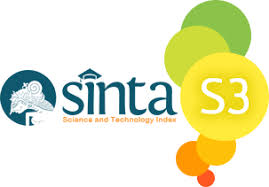Peningkatan Pelayanan Berbasis Strategi Komunikasi Organisasi pada RSUD Luwu
 Abstract views: 1270
,
Abstract views: 1270
,
 PDF downloads: 1979
PDF downloads: 1979
Abstract
The purpose of this study is to describe the organization's communication strategy to improve patient service in Luwuk Regional Public Hospital. In this study, the researcher uses qualitative research method in order to know or to describe the facts of the events studied so that it facilitates the researcher to obtain objective data in order to know and to understand the Organization's Communication Strategy on Service in Luwuk Regional Public Hospital. The result of this research can be concluded that the organization communication strategy related to the effort of delivering message has not supported the occurrence of effective communication yet. This is because the message delivered verbally is unclear to the subordinate so that it needs to re-delivery and submission of information back, medicine naming verbally so that it is misidentified by by the nurse, via phone also raises the unclearness of messages and poor doctor's writing that sometimes complicate the task of a nurse so that it will give impact on service pattern. The second is timing; organizational communication strategy related to timing in the delivery of messages is still not optimal.
Keywords: communication strategy, organization, service
References
Griffin, E. M. (2006). A first look at communication theory. McGraw-Hill.
Gunawan, I. (2013). Metode penelitian kualitatif. Jakarta: Bumi Aksara.
Hardjana, A. M. (2003). Komunikasi interpersonal dan intrapersonal. Kanisius.
Kodir, A & Susilo, D. (2015). CSR dan PR: Sinergitas, Kritik, dan Diskursus Budaya Komunikasi Tanggung Jawab Perusahaan. Surabaya: CV. M- Brothers Indonesia.
Kusnan, A. (2005). Analisis Sikap Iklim Organisasi, Etos Kerja dan Disiplin Kerja dalam Menentukan Efektivitas Kinerja Organisasi di Garnisun Tetap III Surabaya (Doctoral dissertation, UNIVERSITAS AIRLANGGA).
Nerlich, B., Koteyko, N., & Brown, B. (2010). Theory and language of climate change communication. Wiley Interdisciplinary Reviews: Climate Change, 1(1), 97-110..
Rice, A. K. (Ed.). (2013). Productivity and social organization: The Ahmedabad experiment: Technical innovation, work organization and management. Routledge.
Schmidt, J. B., Montoya‐Weiss, M. M., & Massey, A. P. (2001). New product development decision‐making effectiveness: comparing individuals, face‐to‐face teams, and virtual teams. Decision sciences, 32(4), 575-600.
Seaverson, E. L., Grossmeier, J., Miller, T. M., & Anderson, D. R. (2009). The role of incentive design, incentive value, communications strategy, and worksite culture on health risk assessment participation. American Journal of Health Promotion, 23(5), 343-352.
Steyn, B. (2004). From strategy to corporate communication strategy: A conceptualisation. Journal of Communication Management, 8(2), 168-183.
Trisno, B. (2009). ManajemenSumber Daya Manusia. Jakarta: Kencana Prenada Media Group.
Umam, K. (2012). Manajemen Organisasi. Bandung: Pustaka Setia.
Wisnuwardhani, D., & Mashoedi, S. F. (2012). Hubungan interpersonal. Jakarta: Salemba Humanika.
Copyright (c) 2018 Jurnal Komunikasi Profesional

This work is licensed under a Creative Commons Attribution-ShareAlike 4.0 International License.

Jurnal Komunikasi Profesional is licensed under a Creative Commons Attribution-ShareAlike 4.0 International License.
1. Proposed Policy for Journals That Offer Open Access
Authors who publish with this journal agree to the following terms:
- Authors retain copyright and grant the journal right of first publication with the work simultaneously licensed under a Creative Commons Attribution License that allows others to share the work with an acknowledgment of the work's authorship and initial publication in this journal.
- Authors are able to enter into separate, additional contractual arrangements for the non-exclusive distribution of the journal's published version of the work (e.g., post it to an institutional repository or publish it in a book), with an acknowledgement of its initial publication in this journal.
- Authors are permitted and encouraged to post their work online (e.g., in institutional repositories or on their website) prior to and during the submission process, as it can lead to productive exchanges, as well as earlier and greater citation of published work (See The Effect of Open Access).
2. Proposed Policy for Journals That Offer Delayed Open Access
Authors who publish with this journal agree to the following terms:
- Authors retain copyright and grant the journal right of first publication, with the work [SPECIFY PERIOD OF TIME] after publication simultaneously licensed under a Creative Commons Attribution License that allows others to share the work with an acknowledgement of the work's authorship and initial publication in this journal.
- Authors are able to enter into separate, additional contractual arrangements for the non-exclusive distribution of the journal's published version of the work (e.g., post it to an institutional repository or publish it in a book), with an acknowledgement of its initial publication in this journal.
- Authors are permitted and encouraged to post their work online (e.g., in institutional repositories or on their website) prior to and during the submission process, as it can lead to productive exchanges, as well as earlier and greater citation of published work (See The Effect of Open Access).



